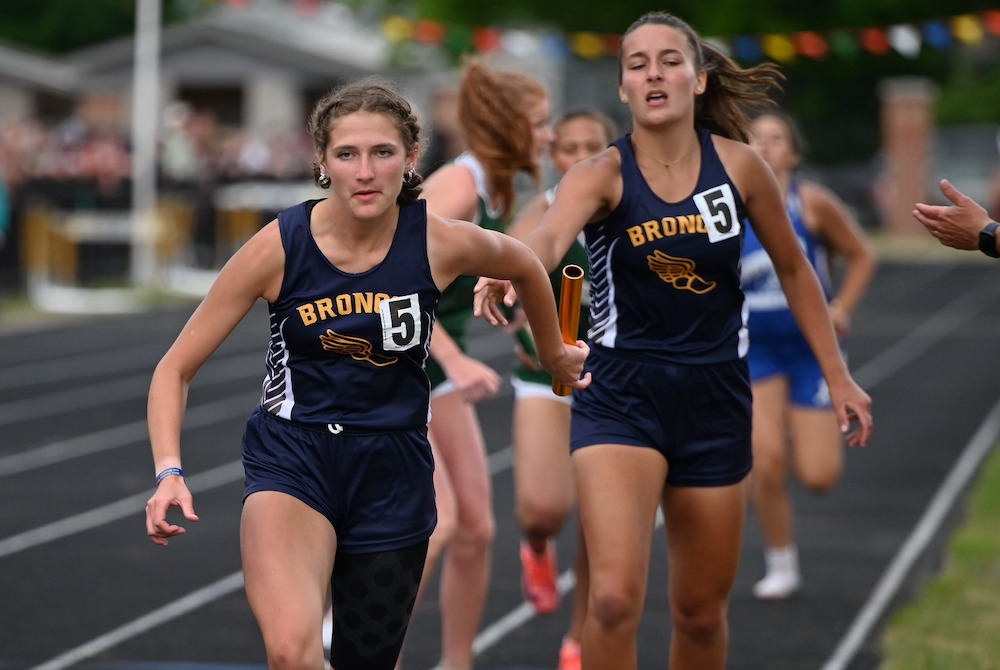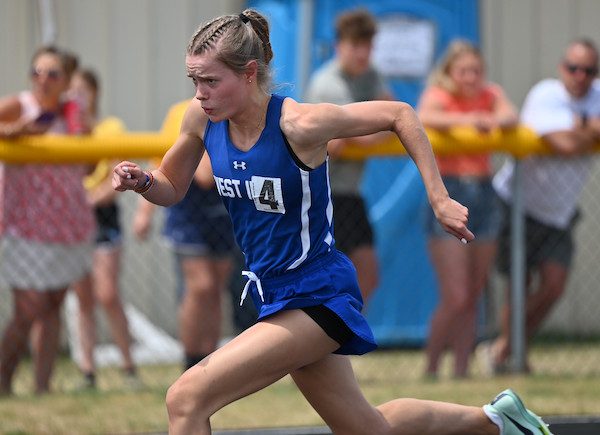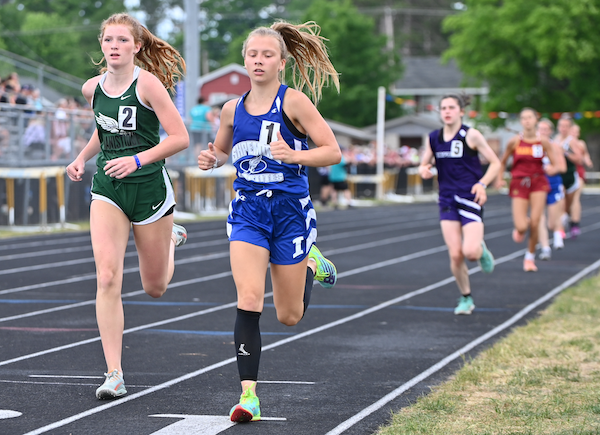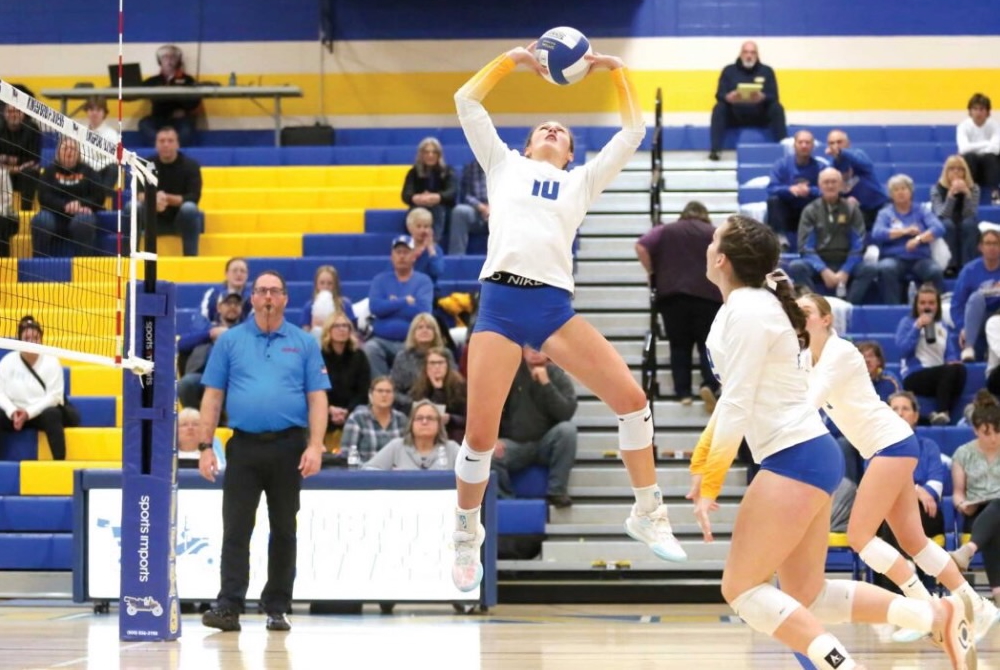
Reigning Champions Rule UPD2 Again with Repeat and 3-Peat Performances
By
Jason Juno
Special for MHSAA.com
June 4, 2023
KINGSFORD – Ishpeming’s Lola Korpi hadn’t lost in the 800, 1,600 or 3,200 at the last two Upper Peninsula Division 2 Finals. The same was true for West Iron County’s Danica Shamion in the 100, 200 and 400.
With that kind of track record, the expectations were through the roof Saturday.
“There’s so much pressure,” the Ishpeming junior said. “People do expect a champion out of me; it gets really hard mentally, there's a lot of pressure on me all the time. But I love to do this. I just love running so much. So I just go out there and do what I can, just do the best I can do.”
Her best continues to be really good.
Korpi won all three of the distance events again, plus she was a member of the first-place 3,200 relay team, which gave her 11 career championships. Shamion, meanwhile, won all of the dashes again as well.
 “It’s been a good day, just really hot out,” Shamion said.
“It’s been a good day, just really hot out,” Shamion said.
Korpi defeated some talented young runners. Pickford freshman Talya Schreiber took second in the 1,600 and 3,200, and Manistique sophomore Leah Goudreau was runner-up in the 800.
“I was challenged on all of them,” Korpi said. “It’s my 200 kick at the end that gets it. Now that I’m a junior I have a lot of experience against all the fast freshmen this year. So I just let them take the lead for a little bit while I coast behind them and then kick it in at the end. Or depending on how I feel, maybe I’ll just go out there right away.”
Her 3,200 relay team, also including Tiana Bosworth, Brittanie Piotrowski and Kadie Kaukola, was down by 200 meters with Hancock in front of them.
“I got the baton and I was just feeling great. I went out and beat her,” Korpi said. “That started the whole team out with a good chunk of points.”
Shamion now has nine individual titles.
She said the 400 dash was her best event of the day. She broke her own Upper Peninsula Division 2 Finals record with a time of 57.18 seconds; she had set the record at 58.77 last year.
 “I PR’d by a second, which I really wanted to, so I’m glad,” Shamion said.
“I PR’d by a second, which I really wanted to, so I’m glad,” Shamion said.
Her goal was to finish that race in 56 seconds.
“I was so close,” she said. “But I’m happy I took my own record that I had.”
Shamion also set a UPD2 Finals record in the 200 with a time of 26.34 seconds. Norway’s Dani Gagne had the previous record (26.42).
Shamion almost won four events. Teammate Calli Pellizzer won the high jump in a tiebreaker as both cleared 4 feet, 10 inches.
“Someone from my team won, good for my team,” Shamion said.
The Wykons finished in fourth place with 73 points.
Bark River-Harris repeated as team champ after winning for the first time in school history last year. The Broncos had 100 points, 13 better than runner-up Ishpeming and 24 ahead of third-place Manistique.
Gwinn’s Lena Pleaugh placed first in both of the hurdles events; she was the 100 champion for the second year in a row.
Pickford’s Kadence Potoczak won discus in Division 2 after earning the UPD3 title last year, Manistique’s Danielle Lund won the shot put, Ishpeming’s Mya Hemmer the long jump and St. Ignace’s Avery Visnaw the pole vault.
The Emeralds won the 400 relay (Emma Jones, Lund, Kelsey Muth and Leah Goudreau), and BR-H won the 800 relay (Mckenzie Hoffmeyer, Lauren Zawada, Julia Olson and Marissa Ives) and 1,600 (Juliian Koch, Julia Nault, Zawada and Olson).
PHOTOS (Top) Bark River-Harris's Lauren Zawada hands off to the fourth leg of their 1,600 relay, Julia Olson, on Saturday. (Middle) West Iron County's Danica Shamion starts her winning 400. (Below) Manistique's Leah Goudreau, left, and Ishpeming's Lola Korpi run the first lap of the 800. (Photos by Cara Kamps/RunMichigan.com.)

Kingsford's Kreider Prepared for Next Level After Finishing Stellar Flivvers Career
By
John Vrancic
Special for MHSAA.com
June 19, 2025
KINGSFORD — After completing a successful high school volleyball career, Maddy Kreider is ready to take the next step.
 The Kingsford senior is taking her talents to Michigan Tech, where she’s expected to continue primarily as a setter.
The Kingsford senior is taking her talents to Michigan Tech, where she’s expected to continue primarily as a setter.
“That will be a big step for sure, but it’ll be exciting being with the girls,” she said. “The girls are taller in college. It will definitely be an adjustment, physically and mentally. We’ll be traveling longer distances, and it’ll be a matter of improving the mental part of my game.”
Kreider was selected the Upper Peninsula’s Defensive Player of the Year her final two seasons after the U.P. Sportswriters and Sportscasters Association began voting for all-U.P. volleyball.
“That’s quite an accomplishment,” she said. “It’s a real honor playing with girls I grew up with. We had a great season.”
The 5-foot-8 setter was a four-year starter and two-year team captain at Kingsford, leading the Flivvers to three Division 2 District titles and back-to-back undefeated Great Northern Conference championships. She twice was named GNC Player of the Year.
She was also selected all-state first team in the fall and all-state second team in 2023, and all-region throughout her prep career. Her serving percentage also topped .900 throughout her four seasons on varsity.
 Last fall, the Flivvers reached the Regional Semifinal at Manistique where they dropped a 3-2 decision to Kingsley.
Last fall, the Flivvers reached the Regional Semifinal at Manistique where they dropped a 3-2 decision to Kingsley.
“I thought we’d get through,” Kreider said. “We came out lights out in the first two sets, then it was close in the last three.”
Also among the team’s highlights this past fall was a victory at Calumet, approximately 2½ weeks after dropping a 3-1 decision to the Copper Kings on Kingsford’s home floor.
“We wanted to play them,” Kreider said. “They’re a great bunch of girls to play against. They’ve been the measuring stick up here for many years. Winning on their floor was super exciting. We knew we had to play well just to be competitive. That was a great confidence builder for our group. We were definitely on a high going into the District.”
The Flivvers opened their postseason with a 3-1 triumph over Houghton, then defeated Escanaba in straight sets in the District Final.
Kreider will join Calumet senior Maddie Torola at MTU this fall. Torola, who recorded a season-high 19 kills in the four-set victory at Kingsford, helped the Copper Kings finish 29-5 and reach the Division 3 Regional Final at Sault Ste. Marie where they dropped a 3-2 decision to Traverse City St. Francis.
“It was fun playing against her in high school,” Kreider said. “It will be even more fun playing as teammates. It’ll be exciting to be playing on the same team.”
Both will be playing under new head coach Cindy Pindral at Tech. Both of Kreider’s parents played for the Huskies, her mother (and Kingsford varsity coach) Jaclynn volleyball from 1998-2002 and her father Jason basketball from 1997-2000.
Maddy Kreider recently earned an additional honor when she was selected Female Athlete of the Year for Kingsford’s Class of 2025. She recently completed a solid track & field season for the Flivvers.
At the U.P. Division 1 Finals, Kreider placed fourth in the 100-meter dash (13.2) and anchored the Flivvers to a third-place finish in the 800 relay (1:51.57) and fourth in the 400 (53.03) on their home track.
Kreider was named one of 32 MHSAA/Farm Bureau Insurance Scholar-Athlete Award winners this winter and plans to study exercise science and kinesiology at MTU.
 John Vrancic has covered high school sports in the Upper Peninsula since joining the Escanaba Daily Press staff in 1985. He is known most prominently across the peninsula for his extensive coverage of cross country and track & field that frequently appears in newspapers from the Wisconsin border to Lake Huron. He received the James Trethewey Award for Distinguished Service in 2015 from the Upper Peninsula Sportswriters and Sportscasters Association.
John Vrancic has covered high school sports in the Upper Peninsula since joining the Escanaba Daily Press staff in 1985. He is known most prominently across the peninsula for his extensive coverage of cross country and track & field that frequently appears in newspapers from the Wisconsin border to Lake Huron. He received the James Trethewey Award for Distinguished Service in 2015 from the Upper Peninsula Sportswriters and Sportscasters Association.
PHOTOS (Top) Kingsford’s Maddy Kreider sets for her teammates during a match last season. (Middle) Kreider, right, takes a photo with Kingsford’s Male Athlete of the Year Gavin Grondin. (Photos provided by the Kingsford athletic department.)

